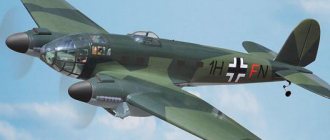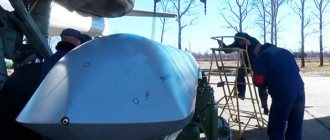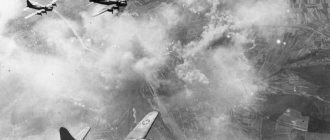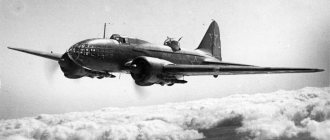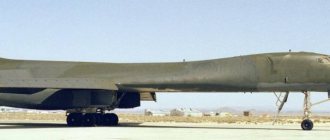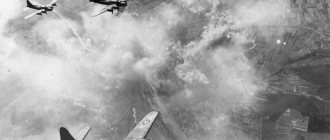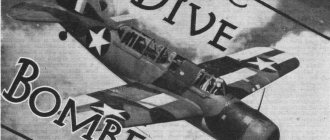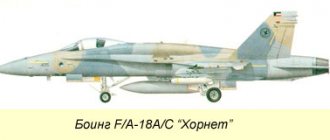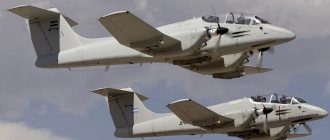− Short-range bomber BB-22 (Yak-2, Yak-4)
A prototype of the high-speed reconnaissance aircraft S-22 with a spaced tail unit, which first flew on February 22, 1939, was developed under the leadership of A.S. Yakovlev, who since 1935 worked as the chief designer of the OKB, and in 1940-1946. at the same time he was deputy people's commissar of the aviation industry. Already during the testing process, the S-22 aircraft was converted into a light bomber, strengthening defensive weapons, increasing fuel reserves and equipping an internal bomb bay. The modified vehicle received the new designation BB-22 (short-range bomber). Serial production of the BB-22 began in December 1939, the first vehicle took off on December 31, and in February 1940 the vehicle was tested with a ski chassis. In addition to the bomber variant, other variants were also developed - the R-12 photo reconnaissance aircraft and the I-29 long-range escort fighter (BB-22 IS). BB-22, equipped with two M-103 engines with a power of 960 hp. s, developed a maximum speed of 530 km/h, had a flight range of 800 km and a service ceiling of 8800 m. In 1940, the aircraft was renamed the Yak-2. During the production process, further improvements were made to the Yak-2 design: the layout of the cockpit was improved, armor protection was strengthened, more powerful M-105 engines were installed, and external bomb racks were installed. The new modification received the designation Yak-4, production of vehicles of this modification began in the fall of 1940. In February 1941, the aircraft was adopted by the Soviet Air Force, but it was not particularly successful in operation, so it was discontinued in April of the same year. In total, about 200 vehicles of both variants were produced, most of them were lost in combat before the end of 1941, while the surviving vehicles were used until 1945.
Characteristics of the BB-22 (Yak-4) bomber: crew - 2 people, power plant - 2 x M-105 with a power of 1100 hp each. s, wingspan - 14.0 m and its area 29.4 m2, aircraft length - 10.18 m, empty weight - 4000 kg, take-off weight - 5845 kg, maximum speed - 574 km/h, range - 1200 km, rate of climb - 920 m/min, service ceiling - 10,000 m, armament - 3 ShKAS machine guns of 7.62 mm caliber and 800 kg of bombs.
read more "
Il-28 - the first Soviet jet bomber
Il-28 at the airfield.
The design of the Il-28 bomber began with the tail. The fact is that the creation of this aircraft became possible thanks to the launch into mass production of a reliable English turbojet engine with a Nin centrifugal compressor, which used a defensive mobile installation, which determined the main layout features of the Il-28.
IL-28 in the sky.
The main advantage of the aircraft was the fact that the Il-28 was stable over the entire speed range. It easily performed any maneuvers necessary for bombers, performing turns with a roll of up to 80 degrees. During a combat turn, the altitude gain reached 2 km.
View from the cockpit of the Il-28.
Il-28 was produced under license in China under the name H-5. The aircraft was widely used in more than 20 countries. In total, about 6 thousand units were produced.
− Long-range bomber DB-2 (ANT-37)
At the end of 1933, Pavel Osipovich Sukhoi, who worked at the Design Bureau A.N. Tupolev at TsAGI, began designing a twin-engine long-range bomber DB-2 (ANT-37), capable of carrying 1000 kg of bombs at a speed of 350 km/h to a range of 3500 km. The aircraft was equipped with two M-85 engines with a power of 800 hp each. With. The prototype was equipped with a rotating turret with one machine gun and a second turret with a coaxial machine gun behind the cockpit. The crew consisted of 3 people - a pilot and two gunners. The vehicle made its first flight on June 15, 1934; during testing it turned out that tail flutter occurs at speeds above 250 km/h. On July 20, test pilot M.M. Gromov managed to land the plane, whose rear fuselage began to collapse in flight at a speed of about 340 km/h.
The second experimental aircraft DB-2bis took off for the first time on February 25, 1936. Tests showed that its speed was below the requirements of the technical specifications, but the range significantly exceeded these requirements. In August 1936, the plane made a non-stop flight along the Moscow-Omsk-Moscow route, which amounted to 4995 km. Although the Air Force showed no interest in the DB-2 aircraft, it was decided to modify the aircraft to perform record-breaking range flights. The engines were replaced with more powerful M-86s, new propellers were installed, the capacity of the fuel tanks was increased, and the weapons were removed. It was expected that as a result of modifications, the range of the aircraft, designated “Rodina,” would increase to 7,000–8,000 km. The Rodina plane with a female crew on board (commander V. Grizodubova, co-pilot P. Osipenko and navigator M. Raskova) took off on September 24, 1938 from the airfield in Monino and headed for the Far East. The flight lasted 26 hours and 29 minutes, during which time the plane flew a distance of 5908 km and landed in the Khabarovsk Territory near the village of Kerbi on the banks of the Amur River.
Tupolev DB-2 bomber paint scheme
Characteristics of the long-range bomber DB-2 (ANT-37): crew - 3 people, power plant - 2 x M-85 with a power of 780 hp each. s, wingspan - 31.0 m and its area - 85.0 m2, aircraft length - 15.0 m, height - 4.19 m, empty weight - 5800 kg, take-off weight - 9456 kg, maximum speed - 342 km /h, range - 4995 km, armament - 3 ShKAS machine guns of 7.62 mm caliber and 1000 kg of bombs.
read more "
Su-34 - generation 4+ bomber
Bomber Su-34 generation 4+.
The Russian 4+ generation bomber was the Su-34 bomber, designed to carry out high-precision strikes against surface and ground targets at any time of the day. Its design ended in the early 1990s.
In the cockpit of the Su-34.
Some elements of the Su-34 are made using Stealth technology. Thus, the aircraft has a reduced degree of reflection of enemy radar radiation while maintaining consistently good aerodynamics. Radar-absorbing materials and coatings made the Su-34 less visible on radar screens than aircraft such as the Su-24, F-111 and F-15E. Another element of the Su-34’s combat survivability is the presence of a second control for the navigator-operator.
Su-34 front-line bomber.
Su-34 front-line bombers, according to experts, are many times superior to their predecessors. The aircraft, whose combat radius exceeds 1000 km, can carry 12 tons of various weapons on board. The bombing accuracy is 5-7 meters. And experts claim that the Su-34 has not yet used up its resource.
− Long-range bomber DB-1 (ANT-36)
The record-breaking range flights of the RD (ANT-25) aircraft became the basis for the decision to convert the ANT-25 into a long-range bomber, so in 1934 the Design Bureau A.N. Tupolev began developing its new modification. Externally, the aircraft, which received the designation DB-1 (ANT-36), was almost no different from its predecessor: a new hood was installed on the engine, a cutout was made in the fuselage for the bomb bay, a gunner's seat was equipped and the equipment necessary for the bomber was installed. Simultaneously with the design, mass production of the ANT-36 was organized. It was planned to build 24 DB-1 bombers, of which 20 by May 1936.
In the fall of 1935, the first production DB-1 was flown, but the military commission refused to accept it as clearly unsuitable for use in the Air Force. The same fate awaited the next seven aircraft, which at best required lengthy development. Of the 18 aircraft built, only 10 aircraft were transferred to the combat unit stationed near Voronezh. Between 1936 and 1937, the average annual flight time for aircraft was only 25-30 hours, although some flew up to 60 hours. Trial operation of the DB-1 showed that the ANT-36 did not have the bomb load and flight speed necessary for aircraft of this class; it was virtually defenseless against modern fighters, but had a very long range.
In these circumstances, the NKAP decided not to waste effort and money on the further development of the ANT-25 design, but to concentrate all efforts on the development of new aircraft ANT-37 (DB-2) and TsKB-30 (DB-3). Characteristics of the DB-1 long-range bomber: crew - 3 people, power plant - 1 x M-34R with a power of 900 hp. s, wingspan - 34.0 m and its area 87.1 m2, aircraft length - 13.0 m, empty weight - 3784 kg, take-off weight - 10,000 kg, maximum speed - 244 km/h, range -10,800 km, service ceiling - 7850 m, armament - 1 YES machine gun and 400 kg of bombs.
read more "
− Long-range bomber Ilyushin DB-3 (Il-4, TsKB-30)
In the second half of 1934, at OKB S.V. Ilyushin, who was also the head of the 1st Main Directorate of the People's Commissariat of Defense Industry, under the leadership of A.A. Senkov developed a bomber project called TsKB-26. In April 1936, the first flight of TsKB-26 took place; in the summer of the same year, test pilot V.K. Kokkinaki set five world records on it and for the first time demonstrated the execution of a loop on an aircraft of this class. The aircraft was not mass-produced. Work on the further development of the aircraft led to the creation of TsKB-30 (DB-3).
Based on the results of flight tests of the first model, during which several world records for speed, range and payload were set on it, construction began on the second model, designated TsKB-30. In the spring of 1936, testing of the TsKB-30 aircraft began, and in August of the same year it was put into service and put into production under the designation DB-3. In 1937, the first DB-3 aircraft entered service with long-range bomber units. In March 1938, the DB-3 passed state tests as a long-range bomber escort aircraft. This vehicle had the factory designation TsKB-54 and was equipped with powerful small arms and artillery weapons to repel attacks by enemy fighters on the formation of escorted bombers. However, this version of the aircraft was not accepted for service, so all work on it was stopped. For Navy aviation, a variant of the aircraft was developed under the designation DB-ZT (torpedo bomber). However, the torpedo bomber could also carry bombs and mines, which made it possible to use it as a conventional bomber and mine layer. In addition, when necessary, it was used as a long-range sea reconnaissance aircraft. Based on DB-ZT aircraft in the fleet in 1939-1940. units of mine and torpedo aviation were formed, the main purpose of which was to destroy enemy ships, mine enemy fairways and exits from naval bases. Since the DB-ZT could only take off from land airfields, at the beginning of 1938 a new version of the aircraft appeared under the designation DB-ZTP (float torpedo bomber). The aircraft was mounted on floats, which, if necessary, were quickly replaced by a wheeled chassis; in addition, it had special equipment that ensured its operation when based at sea (bottom anchor with bollard, anchor winch, etc.). Flight tests of the DB-ZTP were carried out in the summer of 1938, but it did not go into production, since it was much more difficult to operate than the land version. In May 1939, flight tests of the next version of the aircraft began, under the designation DB-3F; based on the test results in the fall, the vehicle was put into service, and later it received the designation Il-4. During the Great Patriotic War, the Il-4 was continuously improved, being produced in bomber and torpedo bomber versions. Il-4 became the main long-range bomber of the Soviet Air Force. The DB-3 aircraft first took part in combat operations against Japanese troops in China, where the Soviet Union delivered 24 aircraft in 1939. Then he participated in the Soviet-Finnish war, where its first modifications, lacking powerful small arms, suffered heavy losses from Finnish aircraft Bristol Bulldog, Gloster Gladiator and Fokker D.XXI.
From the very first days of the Great Patriotic War, DB-3s began to carry out bombing attacks on German military-industrial facilities and airfields. For example, on June 25, as a result of a raid by DB-ZF bombers from the 207th Long-Range Bomber Aviation Regiment on one of the airfields near Vilnius, German Bf 109 fighters of the second group of the 27th Fighter Squadron (II/JG 27) were almost completely destroyed. As a result, I1/JG 27 was withdrawn to Germany for re-equipment and manning. At the beginning of August 1941, the Soviet command was given the task of launching a bomb attack on Berlin from the Cahul airfield on the island of Saaremaa (Ezel Island) in the Baltic Sea. The Luftwaffe command believed that Berlin's powerful air defense, which included 736 anti-aircraft guns, hundreds of fighters, barrage balloons and 160 searchlights, reliably protected the German capital from air strikes. The British could not overcome the air defense of Berlin, and the United States did not even try to bomb the German capital until January 1943. Therefore, the bombing attack of Soviet aircraft on Berlin, planned for early August 1941, was then of great political significance.
Based on the decision of the Headquarters, 15 crews from the 1st mine and torpedo regiment of the Baltic Fleet aviation were trained. On the night of August 4–5, five DB-ZF aircraft carried out a reconnaissance flight to Berlin. It was established that the anti-aircraft defense was located in a ring around the city within a radius of 100 km. On the appointed date, August 7 at 21:00, a group of 15 DB-ZF bombers, led by regiment commander Colonel E.N. Preobrazhensky, rose into the air. At about one o'clock in the morning, having dropped bombs on Berlin, the planes turned north towards the sea. Only then did Berlin's air defense catch on - the searchlights turned on, the anti-aircraft guns started working, and night fighters with their headlights on took to the air. The gunners of our bombers fought back with all onboard machine guns, and only over the Baltic did the German fighters fall behind. All our vehicles returned safely to base. The next day, German newspapers reported: “British aircraft bombed Berlin. There are killed and wounded. Six British planes shot down." English newspapers were quick to refute this version: their planes did not appear over Berlin that day. There was no reason not to believe this, so the Germans had to admit that this successful raid was carried out by Soviet aircraft, contrary to Goebbels’ propaganda statements about the “complete destruction of Soviet aviation.”
Torpedo bomber DB-3T2M-87B from the 1st Guards Mine and Torpedo Aviation Regiment, winter 1942-1943.
The raids on Berlin turned into a long and complex operation. They ended on September 5, 1941, by which time ten raids (90 sorties) had been carried out, as a result of which 327 bombs weighing 250 kg were dropped and 32 fires were recorded, our losses amounted to 4 bombers. In addition to DB-ZF aircraft, Pe-8 bombers under the command of Hero of the Soviet Union M.V. also took part in these raids. Vodopyanova. By decrees of the Presidium of the Supreme Soviet of the USSR, ten pilots who participated in the raids on Berlin were awarded the title of Hero of the Soviet Union, 13 pilots received the Order of Lenin and 55 were awarded the Order of the Red Star and the Red Banner of Battle. A total of 1,528 DB-3 and 5,256 DB-ZF (Il-4) aircraft were built in various modifications.
Long-range bomber DB-ZF (IL-4) from the 2nd air regiment of the USSR Black Sea Fleet Air Force, 1941.
Characteristics of the TsKB-26 bomber: crew - 2 (3) people, power plant -2 x M-85 with a power of 760 hp each. s, wing span - 21.4 m and its area - 65.5 m2, length - 13.7 m, height - 3.8 m, empty weight - 4000 kg, take-off weight - 6000 kg, maximum speed - 390 km/ h, range - 4000 km, rate of climb - 331 m/min, service ceiling - 10,000 m, armament - 1000 kg of bombs. Characteristics of the DB-3 long-range bomber: crew - 3 people, power plant - 2 x M-87A with a power of 950 hp each. s, wingspan - 21.44 m and its area - 65.5 m2, aircraft length - 14.22 m, height - 4.19 m, empty weight - 5270 kg, take-off weight - 9500 kg, maximum speed - 439 km / h, range - 3800 km, service ceiling - 9300 m, armament - 3 ShKAS machine guns of 7.62 mm caliber and 2500 kg of bombs. Characteristics of the DB-3T torpedo bomber: crew - 3 people, power plant - 2 x M-85 with a power of 780 hp each. s, wingspan - 21.44 m and its area - 65.6 m2, aircraft length - 14.22 m, height - 4.19 m, empty weight - 4298 kg, take-off weight - 6494 kg, maximum speed - 395 km / h, range - 1800 km, service ceiling - 7800 m, armament - 3 ShKAS machine guns of 7.62 mm caliber, 1000 kg of bombs (min) or 1 torpedo weighing 940 kg.
Il-4 bomber "Amursky Komsomolets" from the 2nd air squadron of the 2nd Guards long-range bomber air regiment.
Characteristics of the Il-4T torpedo bomber: crew - 4 people, power plant - 2 x M-88B with a power of 1100 hp each. s, wingspan - 21.44 m and its area - 66.7 m2, aircraft length - 14.76 m, height - 4.19 m, empty weight - 5800 kg, take-off weight - 11,570 kg, maximum speed - 430 km/h, range - 3800 km, service ceiling - 9700 m, armament - 1 UBT machine gun of 12.7 mm caliber, 2 ShKAS machine guns of 7.62 mm caliber and 1 torpedo weighing 940 kg.
Long-range bomber DB-3, captured by the Nazis during the Soviet-Finnish War and sent for study at the Luftwaffe research center in Rechlin (Germany).
read more "
Ilya Muromets - the world's first bomber
Bomber Ilya Muromets (1913)
The world's first bomber was created in Russia in 1913 by Igor Sikorsky and was named in honor of the epic hero. “Ilya Muromets” was the name given to various modifications of this aircraft, which were produced in Russia from 1913 to 1917. The main parts of the aircraft were wooden. The lower and upper wings were assembled from separate parts and connected via connectors. The wingspan of the first bomber was 32 meters. Since aircraft engines were not produced in Russia in those years, German-made Argus engines were installed on the Ilya Muromets. The domestic R-BV3 engine was installed on the bomber in 1915.
Bomber Ilya Muromets, created by designer Sikorsky.
“Ilya Muromets” had 4 engines, and even stopping two engines could not force the plane to land. During the flight, people could walk on the wings of the plane, and this did not affect the balance of the plane. Sikorsky himself went out on the wing during testing of the aircraft to make sure that, if necessary, the pilot could repair the engine right in the air.
The cockpit of the Ilya Muromets bomber.
At the end of December 1914, Emperor Nicholas II approved the resolution of the Military Council on the creation of the “Airship Squadron”, which became the world’s first bomber formation. The planes of the Russian squadron took off for the first combat mission on February 27, 1915. The first flight was unsuccessful, because the pilots got lost and did not find the target. The next day, the mission was completed successfully: the pilots dropped 5 bombs on the railway station, and the bombs fell right among the rolling stock. The result of the bomber raid was captured in the photo. In addition to bombs, the Ilya Muromets bomber was armed with a machine gun.
Ilya Muromets in the air.
In total, during the First World War, Russian bombers made 400 sorties, dropping 65 tons of bombs and destroying 12 enemy fighters. Combat losses amounted to only one aircraft.
− High-speed long-range bomber Ilyushin DB-4 (TsKB-56)
In 1939, OKB S.V. Ilyushin began developing a high-speed long-range bomber DB-4 (TsKB-56). It was assumed that the aircraft would be equipped with two M-120 or AM-36 engines, which were under development at that time. Compared to the DB-ZF, the new bomber was larger in size, had a two-tail tail, and the crew of the aircraft consisted of 4 people. By October 1940, a prototype DB-4 was built, which, due to the lack of completed M-120 or AM-36 engines, was equipped with AM-37 engines. The first flight of the prototype took place on October 15, 1940; during testing, many shortcomings were revealed that were taken into account and eliminated during the construction of the second prototype. However, after several flights during factory tests, they decided not to submit the DB-4 for state tests, but to stop all work on it, since in October 1940 the Er-2 bomber of the same class was launched into production.
Sketch of an experienced bomber Ilyushin DB-4
Characteristics of the DB-4 (TsKB-56) high-speed bomber: crew - 4 people, power plant - 2 x AM-37 with a power of 1030 hp each. s, wingspan - 25.0 m and its area - 83.0 m2, aircraft length - 17.85 m, height - 5.1 m, empty weight - 7561 kg, take-off weight - 13,000 kg, maximum speed - 500 km/h, range - 4000 km, service ceiling - 10,000 m, armament - 3-4 ShKAS machine guns of 7.62 mm caliber and 3000 kg of bombs.
read more "
M-4 BISON - strategic intercontinental jet bomber
M-4 BISON - strategic intercontinental jet bomber
In the late 1940s, with the advent of nuclear weapons, a need arose for means of their delivery. Bombers were needed that were approximately 2 times superior in technical characteristics to existing ones. The Americans were the first to begin developing the concept of such an aircraft. This is how the B-60 and B-52 appeared, which took to the air in the spring of 1953. In the USSR, work on a bomber of this class began with a significant delay. Stalin entrusted the development of the aircraft to MAI professor V. Myasishchev, who submitted to the government a scientifically based proposal to create a strategic aircraft with a flight range of 11,000 - 12,000 km, but very strict deadlines were set for the implementation of the project. By December 1952, a prototype of the aircraft was built, and in January 1953, the M-4 bomber - an eight-seat cantilever all-metal mid-wing, equipped with 4 engines and a retractable bicycle-type landing gear - made its first flight.
M-4 BISON - strategic intercontinental jet bomber
As a result of changes and modifications, an aircraft was created whose flight range, in comparison with earlier models, increased by 40% and exceeded 15 thousand km. The flight duration with one refueling was 20 hours, which made it possible to use the M-4 as an intercontinental strategic bomber. Another innovation - the new bomber could be used as a long-range sea torpedo bomber.
The tactics for using the M-4 included flying these aircraft in formation as part of a squadron or regiment at an altitude of 8-11 km. Approaching the target, the planes broke formation and each bomber carried out an attack on its own target. Thanks to the cannon armament system, the bomber could effectively counter interceptor aircraft. The aircraft were officially withdrawn from service in 1994.
− Long-range bomber Bolkhovitinov DB-A
In 1933, a group of teachers and engineers of the Air Force Academy under the leadership of Viktor Fedorovich Bolkhovitinov, chief designer since 1937, began work on the deep modernization of the TB-3 bomber. The prototype, designated DB-A (DB-Academy), was ready in November 1934; it first flew on May 2, 1935, equipped with four M-34RN engines. Flight tests of the DB-A aircraft showed that it is superior to its predecessor in all respects. Moreover, it set several world records for carrying capacity, and after some modifications, the vehicle, which received the civilian designation N-209, was prepared in August 1937 for a non-stop flight from Moscow through the North Pole to America (Fairbanks, Alaska). However, soon after the plane, whose crew commander was S.A. Levanevsky, reported on the radio that it was flying over the North Pole, communication with the plane was lost. The subsequent months-long search for the plane led to nothing.
Despite the tragedy that occurred with the first experimental aircraft, the second experimental aircraft, designated DB-2A, with more powerful M-34FRN engines, underwent state tests. Based on the test results, a small series of 16 vehicles was ordered in 1938. By the end of 1939, 12 vehicles were built, but the following year the remaining 4 vehicles were not built, since the more advanced TB-7 bomber went into production.
Other projects were also developed, in particular the long-range bomber BDD (a faster modification of the DB-A with four .M-34FRN engines) and the heavy cruiser TK-1, equipped with powerful weapons (3 cannons, 5 machine guns and 8 rockets).
Characteristics of the Bolkhovitinov DB-A bomber: crew - 7 people, power plant - 4 x M-34RN with a power of 900 hp each. s, wingspan - 39.5 m and its area - 230 m2, aircraft length - 24.4 m, empty weight - 15,400 kg, take-off weight - 21,900 kg, maximum speed - 316 km/h, range - 4500 km , service ceiling - 7730 m, armament - 1 ShVAK cannon of 20 mm caliber, 6 ShKAS machine guns of 7.62 mm caliber and 6500 kg of bombs.
read more » « List of tags
THANK YOU FOR REPOSTING THE ARTICLE, FRIENDS!
Savoia-Marchetti SM.79 Sparviero - exotic in battle
When we talk about medium bombers, we usually mean twin-engine aircraft. However, this rule does not apply in Italy. Three-engine cars in the 1930s and 1940s were not anything super exotic; just remember the German Ju-52. However, the Italians’ love for three-engine vehicles goes beyond all limits.
There were really a lot of them - Caproni Ca.133, Piaggio P.16, Cant Z.1007 Alcione... And, finally, SM.79 Sparviero. Not the best, not the most successful bomber, but, of course, it is the one that is most suitable for the role of a symbol of the Italian bomber aviation of World War II.
The three-motor design has its advantages, the main one being reliability. Three motors - not two. And if one engine fails during flight, then a two-engine machine will lose half of its power, and a three-engine machine will lose only a third. However, there are many more disadvantages in such a scheme - mechanics on the ground have more work, more spare parts are required, three motors weigh more than two of the same power.
In addition, the third engine installed in the bow made it impossible to place a bombardier's cabin and a shooting point there. The designers solved the defense problem by installing a fixed machine gun on a large hump, but this solution was obviously weak even then. The bombardier on the Sparviero was placed... in the ventral gondola closer to the tail. In this case, the plane was controlled by a “one and a half” set of pilots - the flight mechanic joined the commander during takeoff and landing (the scheme was quite popular at that time, just remember the He-111 and the British Handley-Page Halifax).
It is interesting that, like the He-111, this aircraft is of peaceful origin, moreover, of passenger origin. However, in this case, this cannot be considered a virtue - what is done for peaceful purposes is not very useful in war. However, the Savoia-Marchetti eight-seater passenger aircraft, ready in 1934, was one of the fastest in Italy, and it would be strange not to try to put it up for competition for the military who wanted to get a modern bomber.
No miracle happened. The high-speed business jet did not become a good military aircraft. He lacked the power of three Alfa Romeo engines of 750 hp each. With. each, despite the 12.7 mm machine guns at three points - the front installation, the upper turret and the gondola, it was rather weakly armed, the gas tanks were not protected, which also made the aircraft vulnerable.
Nevertheless, the Italians built more than 1,300 of these machines, which not only flew until the end of the war, but also later served in various Middle Eastern countries. The last Sparviero was scrapped in Lebanon in 1959.
The Axis medium bombers seemed like a real nightmare in the first years of the war - numerous air armadas with trained crews, directed by skillful command, seemed unstoppable. But no luck lasts forever. The Allies’ response was not long in coming, and we will talk about the soldiers of the air war of the Anti-Hitler coalition next time.
